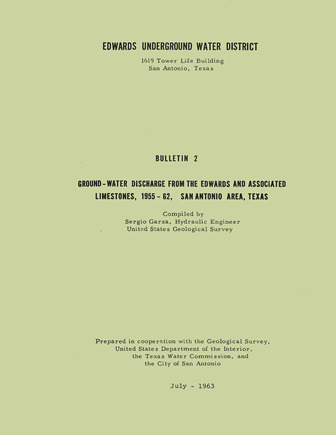Ground-Water Discharge from the Edwards and Associated Limestones, 1955-62, San Antonio Area, Texas

| Author | Garza S (US Geological Survey) |
| Year | 1963 |
| Description | First of annual reports on discharge from the Edwards Aquifer issued by the Edwards Underground Water District |
| Report Number | Bulletin 2 |
| Publisher | Edwards Underground Water District |
| Location | Edwards Aquifer Balcones Fault Zone San Antonio Segment |
| Summary |
|
The program to collect records of groundwater discharge from the Edwards and associated limestones in the San Antonio area is part of the overall hydrologic investigation by the U.S. Geological Survey in cooperation with the Edwards Underground Water District, the Texas Water Commission, and the city of San Antonio . The investigation has been carried on for many years and has resulted in numerous reports on the area. More recent reports summarizing the geology and hydrology of the area are those by Petitt and George {1956) and Garza (1962). The partial records presented in tables 1 and 2 include records of discharge during the latter part of the long drought which extended from about 1947 to 1957, together with the discharge data for the period since the end of the drought through 1962. The spring discharge is the discharge from San Marcos Springs at San Marcos, Comal Springs at New Braunfels, San Antonio and San Pedro Springs at San Antonio, and the Leona River Springs near Uvalde. Most of the well discharge is from wells used by municipalities, military bases, and irrigation projects. Irrigated acreage has increased from about 29, 000 in 1955 to more than 35,000 in 1962. During the same period , the discharge from industrial and from domestic and stock wells has remained relatively constant. Miscellaneous uses include air conditioning, private schools and country clubs , fish and wildlife, and wastes from flowing wells. In Comal and Hays Counties, all but a small part of the discharge is from Comal and San Marcos Springs, respectively, whereas in the remaining counties, most of the discharge is from wells. The largest part of the discharge from wells is in Bexar County ; the discharge figures for Bexar County also include the discharge from a few wells in northwest Atascosa and Guadalupe Counties . Most of the discharge from wells in Medina and Uvalde Counties is used for irrigation. |
Search for Documents
Advance Search
Explore EAA's Scientific Reports
- All Reports
- Groundwater Recharge, Recharge Zone
- Groundwater Movement
- Geomorphology and Caves
- Weather Modification
- Geology
- Water Use and Conservation
- Geochemistry
- Water Resources Planning and Management
- Floods and Drought
- Water Quality
- Climatology
- Surface Water / Groundwater Relationship
- Biology
- Springs, Groundwater Discharge
- Archaeology
- RZ Protection
- Aquifer Levels
- Remote Sensing
- Precipitation
- Overview Studies
- Modeling
- Hydrology and Hydrogeology
- History
